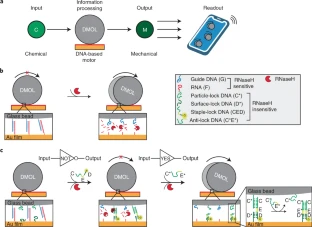Phys.org March 29, 2022
In general, DNA computation conducted in individual tubes is slow in generating chemical outputs in response to chemical inputs and requires fluorescence readout. Researchers at Emory University have introduced a new paradigm for DNA computation where the chemical input is processed and transduced into a mechanical output using dynamic DNA-based motors operating far from equilibrium. They applied DNA as a coating to extremely small glass beads. In practice, the glass beads either roll across the surface of a base of gold or hold steady, depending on how the DNA coating interacts with molecules that have been attached to the surface of the chip. In their scenario, a “1” is represented by a roll, while a “0” is represented by a motionless bead. Outputs could be detected using a conventional smartphone camera, thus transducing chemical information into the electronic domain in a facile manner, suggesting potential applications. According to the researchers their DNA computer can provide results in just 15 minutes…read more. TECHNICAL ARTICLE

Schematic of DMOLs detecting the presence of a chemical input. Credit: Nature Nanotechnology (2022)